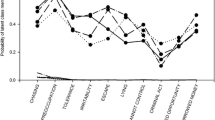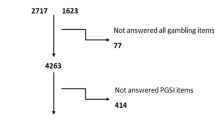Abstract
The South Oaks Gambling Screen (SOGS) is widely used to assess the prevalence of pathological gambling. For a variety of reasons, this instrument may not provide an accurate rate of the prevalence of pathological gambling. In this paper, one source of error in data provided by the SOGS is investigated. It is argued that individuals may not fully understand the meaning of some items, and that clarification of the meaning of misunderstood items may in some cases lead to a changed score on the scale. The present study evaluates respondents' understanding of the SOGS items. The results from three studies are reported, each using a different sample: grade school children, adolescents and adults. It was hypothesised that (1) participants would not understand some items of the SOGS, (2) problem gamblers and probable pathological gamblers would be more inclined to interpret items incorrectly than would non-problem gamblers and, (3) consistent with the first two hypotheses, clarification of items would decrease the number of participants identified as problem gamblers or probable pathological gamblers. The data obtained supported hypotheses 1 and 3. Furthermore, hypothesis 2 was supported for grade school children, but not for adolescents or adults. These results are consistent with recent literature on endorsement and acquiescence phenomena, and have implications for prevalence studies of probable pathological gambling.
Similar content being viewed by others
REFERENCES
Abbot, M. W. & Volberg, R. A. (1992). Frequent gamblers and problem gamblers in New Zealand. Research Series no. 14. New Zealand Department of Internal Affairs.
Abbot, M. W. & Volberg, R. A. ( 1996). The New Zealand National Survey of problem and pathological gambling. Journal of Gambling Studies, 12, 143-160.
American Psychiatric Association. (1980). Diagnostic and statistical manual of mental disorder (3rd ed.). Washington, DC: Author.
Beconia, E. (1996). Prevalence surveys of problem and pathological gambling in Europe: The cases of Germany, Holland and Spain. Journal of Gambling Studies, 12, 179-192.
Couch, A., & Keniston, K. (1961). Agreeing response set and social desirability. Journal of Educational Psychology, 33, 401-415.
Custer, R., & Milt, H. (1985). When luck runs out. New York: Werner Books.
Dickerson, M. G. (1993). A preliminary exploration of a two-stage methodology in the assessment of the extent and degree of gambling related problems in the Australian population. In W. R. Eadington & J. A. Cornelius (Eds.), Gambling behavior and gambling problem (pp. 347-364). Reno: Institute for the Study of Gambling and Commercial Gaming.
Dickerson, M. G., Baron, E., Hong, S.-M., & Cottrell, D. (1996). Estimating the extent and degree of gambling related problems in the Australian population: A national survey. Journal of Gambling Studies, 12, 161-178.
Dubé, D., Freeston, M. H., & Ladouceur, R. (1996). Potential and probable pathological gamblers: where do the differences lie? Journal of Gambling Studies, 12, 419-430.
Gambino, B. (1997). The correction for bias in prevalence estimation with screening tests. Journal of Gambling Studies, 13, 343-352.
Gilbert, D. T. (1991). How mental system believe. American Psychologist, 46, 107-119.
Govoni, R., Rupcich, N., & Frish, R. (1996). Gambling behavior of adolescent gamblers. Journal of Gambling Studies, 12, 305-318.
Gupta, R., & Derevensky, J. L. (1999). Adolescent gambling behavior: A prevalence study and examination of the correlates associated with problem gambling. Journal of Gambling Studies, 14, 319-345.
Kazdin, A. E. (1998). Research design in clinical psychology (3rd ed.). Boston: Allyn and Bacon.
Knowles, E. S., & Condon, C. A. (1999). Why people say “yes”: A dual-process theory of acquiescence. Journal of Personality and Social Psychology, 77, 379-386.
Knowles, E. S., & Nathan, K. T. (1997). Acquiescent responding in self-reports: Cognitive style or social concern? Journal of Research in Personality, 31, 293-301.
Krosnick, J. A. (1999). Survey research, Annual Review Psychology, 5, 537-567.
Ladouceur, R., Boudreault, N., Jacques, C., & Vitaro, F. (1999). Pathological gambling and related problems among adolescents. Journal of Child & Adolescent Substance Abuse, 8(4), 55-68.
Ladouceur, R., Ferland, F., Jacques, C Boudreault, N. (1997, June). At what age is pathological gambling most prevalent in childhood or adolescence? Paper presented at the meeting of the 10th International Conference on Gambling and Risk-Taking, Montréal, Canada.
Lesieur, H. R., & Blume, S. B. (1987). The South Oaks Gambling Screen (The SOGS). A new instrument for the identification of pathological gamblers. American Journal of Psychiatry, 144, 1184-1188.
Lorenz, V. C. (1987). Family dynamics of pathological gamblers. In T. Galski, (Ed.), A handbook on pathological gambling. Springfield, IL: Charles C. Thomas.
McGee, R. K. (1967). Response set in relation to personality: An orientation. In I. A. Berg (Ed.), Response set in personality assessment (pp. 1-31). Chicago: Aldine.
Shaffer, H. J., & Hall, M. N. (1996). Estimating the prevalence of adolescent gambling disorders: A quantitative synthesis and guide toward standard gambling nomenclature. Journal of Gambling Studies, 12, 193-214.
Shaffer, H. J., Hall, M. N., & Vander Bilt, J. (1997). Estimating the prevalence of disordered gambling behavior in the United States and Canada: A meta-analysis. Boston: Harvard Medical School.
Schwartz, N. (1999). Self-reports: How the questions shape the answers. American Psychologist, 54, 93-105.
Volberg, R. A., & Steadman, H. J. (1988). Refining prevalence estimates of pathological gambling. American Journal of Psychiatry 145, 502-505.
Volberg, R. A., & Steadman, H. J. (1989). Prevalence estimates of pathological gambling in New Jersey and Maryland. American Journal of Psychiatry, 146, 1618-1619.
Walker, M. B. (1992). The psychology of gambling. New York: Pergamon.
Walker, M. B., & Dickerson, M. G. (1996). The prevalence of problem and pathological gambling: A critical analysis. Journal of Gambling Studies, 12, 233-249.
Winters, K. C., Stinchfield, R. D., & Fulkerson, J. (1993a). Patterns and characteristics of adolescent gambling. Journal of Gambling Studies, 9, 371-386.
Winters, K. C., Stinchfield, R. D., & Fulkerson, J. (1993b). Toward the development of an adolescent gambling problem severity scale. Journal of Gambling Studies, 9, 63-84.
Wynne, H. J. Smith, G. J., & Jacobs, D. F. (1996). Adolescent gambling and problem gambling in Alberta. Edmonton: Alberta Alcohol and Drug Abuse.
Author information
Authors and Affiliations
Rights and permissions
About this article
Cite this article
Ladouceur, R., Bouchard, C., Rhéaume, N. et al. Is the SOGS an Accurate Measure of Pathological Gambling Among Children, Adolescents and Adults?. J Gambl Stud 16, 1–24 (2000). https://doi.org/10.1023/A:1009443516329
Issue Date:
DOI: https://doi.org/10.1023/A:1009443516329




